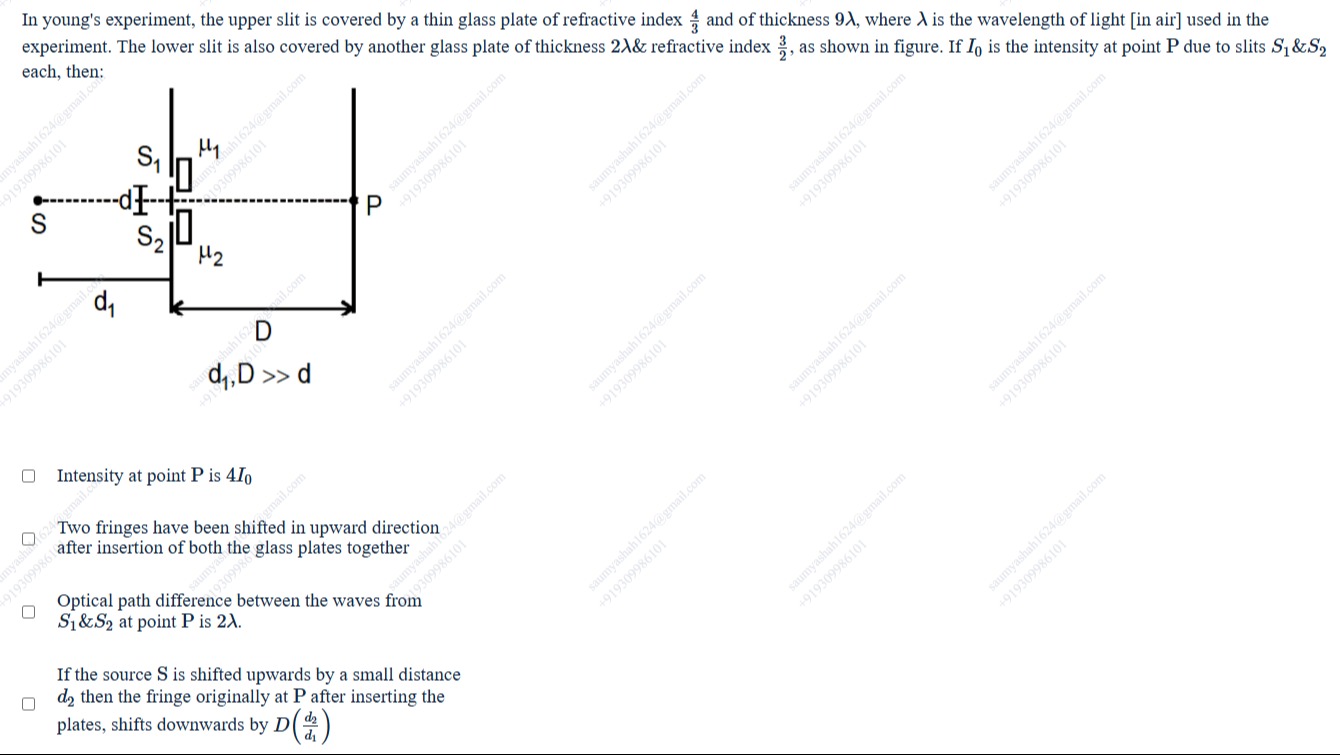Question
Question: In young's experiment, the upper slit is covered by a thin glass plate of refractive index $\frac{4}...
In young's experiment, the upper slit is covered by a thin glass plate of refractive index 34 and of thickness 9λ, where λ is the wavelength of light [in air] used in the experiment. The lower slit is also covered by another glass plate of thickness 2λ & refractive index 23, as shown in figure. If I0 is the intensity at point P due to slits S1 & S2 each, then:

Intensity at point P is 4I0
Two fringes have been shifted in upward direction after insertion of both the glass plates together
Optical path difference between the waves from S1 & S2 at point P is 2λ.
If the source S is shifted upwards by a small distance d2 then the fringe originally at P after inserting the plates, shifts downwards by D(d1d2)
Options 1, 3, and 4 are correct.
Solution
Solution:
-
Extra Optical Path:
When a glass plate of thickness t and refractive index μ is inserted, the extra path compared to air is (μ−1)t.- For the upper slit (S₁): Δ1=(34−1)⋅9λ=31⋅9λ=3λ.
- For the lower slit (S₂): Δ2=(23−1)⋅2λ=21⋅2λ=λ.
Thus, the net extra path difference is:
Δ=Δ1−Δ2=3λ−λ=2λ.This extra path difference (2λ) produces a phase difference of
λ2λ×2π=4π,which is equivalent to zero phase (i.e. constructive interference).
-
Intensity at Point P:
Itotal=(I0+I0)2=(2I0)2=4I0.
With each slit producing intensity I0 and the waves being in phase, the resultant amplitude adds, so: -
Fringe Shift Due to Plates:
δgeom+2λ=mλ.
The extra path difference Δ=2λ would require a geometrical compensation of 2λ for the central maximum. In our geometry, the condition for constructive interference becomes:For m=0 (the new central fringe) we get:
δgeom=−2λ,meaning the central maximum shifts from its original position. Since the extra delay is greater in the upper slit (S₁), the compensation is achieved by moving the point on the screen opposite to S₁, i.e. downward rather than upward. So the statement that "Two fringes have been shifted in upward direction" is incorrect.
-
Effect of Shifting Source S:
In Young’s experiment, if the source S is moved vertically by a small displacement d2 (with d1 being the distance from the source to the slit plane), the fringe pattern on the screen shifts in the opposite direction by an amount proportional to d1Dd2 (where D is the slit-screen distance). Hence, after the plate insertion, if S is shifted upward by d2, the fringe originally at point P shifts downward by D(d1d2).
